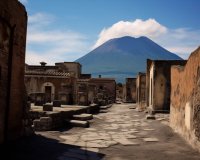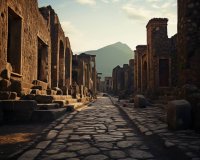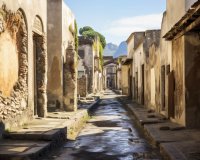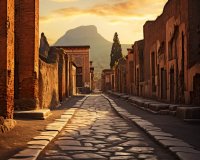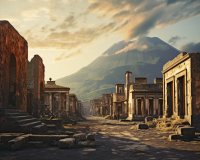Unearthing the Past: Treasures of Pompeii and Herculaneum
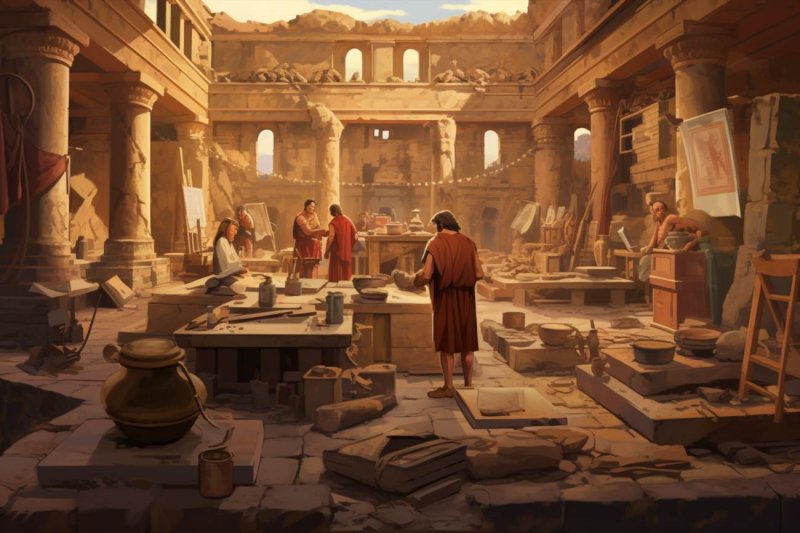
Unearthing the Past: Treasures of Pompeii and Herculaneum
Pompeii and Herculaneum, two ancient Roman cities, have captured the world's imagination for centuries. These cities were buried under layers of volcanic ash and pumice when Mount Vesuvius erupted in 79 AD, preserving a snapshot of daily life in the Roman Empire. In this article, we will explore the fascinating treasures unearthed from the depths of these ancient cities.
The Tragic Eruption:
Mount Vesuvius, a volcano located near modern-day Naples, Italy, erupted in a catastrophic event that obliterated Pompeii and Herculaneum. The volcanic ash, heat, and toxic gases rapidly buried the cities, effectively freezing them in time. This natural disaster, while devastating, inadvertently became a time capsule, offering modern archaeologists and historians a glimpse into the past.
Rediscovery and Excavation:
While these cities were lost to history, they were not forgotten. In the 16th century, explorers began rediscovering the remnants of Pompeii and Herculaneum. However, it wasn't until the 18th century that systematic excavations began. These excavations have continued to this day, unearthing a treasure trove of artifacts and information about life in ancient Rome.
Everyday Life Preserved:
The excavations have revealed remarkably well-preserved buildings, streets, and even the organic remains of food, textiles, and wooden furniture. The level of preservation is extraordinary, offering a unique window into Roman life. Frescoes, mosaics, and sculptures found in these cities provide insights into the art and aesthetics of the time.
The Villa of the Mysteries:
One of the most famous discoveries in Pompeii is the Villa of the Mysteries. This villa is known for its stunning frescoes, which depict a mysterious initiation ritual. These paintings have sparked debates among scholars about their meaning and the cult they represent.
The Herculaneum Papyri:
In Herculaneum, a significant find was made in the form of ancient papyrus scrolls. These scrolls, carbonized by the volcanic eruption, contain Greek and Latin texts, shedding light on various aspects of Roman life, from philosophy to literature.
Pompeii's Amphitheatre:
Pompeii boasts one of the best-preserved ancient amphitheaters in the world. This grand arena once hosted gladiator battles and other events. The structure's well-preserved state allows visitors to step back in time and imagine the roaring crowds and epic battles that once took place there.
The Challenge of Preservation:
While the ongoing excavations continue to reveal incredible finds, the preservation of these cities is an ongoing challenge. Weather, pollution, and tourism can all take their toll on the ancient ruins. Efforts to protect and conserve these treasures are constant, as they hold immeasurable value for our understanding of history.
Visiting Pompeii and Herculaneum:
Today, both Pompeii and Herculaneum are UNESCO World Heritage Sites and open to the public. Visitors can walk through the streets of these ancient cities, marvel at the well-preserved architecture, and see the incredible artifacts in museums dedicated to their history.
In conclusion, the treasures of Pompeii and Herculaneum are a testament to the enduring power of history. The eruption of Mount Vesuvius may have been a tragedy for the people living in these cities, but it has allowed us to glimpse the past in a way that few other archaeological sites can. These sites continue to captivate and inspire, reminding us of the richness of our shared human history.
Private Transfer from Naples to Amalfi-Ravello with Pompeii Guided Tour
Embark on a seamless journey from Naples to the picturesque destinations of Amalfi and Ravello with our professional transfer service. Experience the convenience of being picked up at Naples Airport, Central Station, or your hotel in a modern minivan driven by a skilled chauffeur. As you relax, enjoy the scenic drive along the winding Sorrentine peninsula roads, offering breathtaking views of the Bay of Naples and Capri Island.
During the trip, delve into history with a stop at Pompeii, one of the world's most captivating archaeological sites. Our expert guide will lead you on a private two-hour walking tour, unveiling the secrets of this ancient city. Explore significant landmarks such as the Forum, Marina Gate, and the Basilica, gaining insights into the lives of the ancient Romans. Witness the intriguing plaster casts and visit the Lupanar (brothel), the house of the Tragic Poet, and more, providing you with a comprehensive understanding of Pompeii's rich heritage.
Upon reaching Amalfi-Ravello, enjoy a hassle-free drop-off at your accommodation. Our drivers are not only punctual but also knowledgeable, enriching your journey with informative tidbits along the way. With all taxes, gas, and skip-the-line admission fees included, this transfer service ensures a smooth and informative travel experience.
Highlights:
- Comfortable private transfer from Naples to Amalfi-Ravello in a modern minivan
- Guided two-hour walking tour of Pompeii with an experienced archaeologist
- Explore Pompeii's key attractions, including the Forum, Lupanar, and ancient villas
- Scenic drive along the Sorrentine peninsula, offering panoramic views of the Bay of Naples and Capri
- Insightful commentary from our knowledgeable driver
- Hassle-free drop-off at your accommodation in Amalfi-Ravello
Additional Information:
- Car seats for babies available upon request
- Languages available: Spanish, English, French, German, Italian
- Price: From €353 per person
Book your spot today and embark on a memorable journey through history and scenic beauty!
Daily Life in Ancient Pompeii
Pompeii, an ancient Roman city located near modern-day Naples in Italy, provides a fascinating glimpse into daily life during the Roman Empire's peak. The city was buried under layers of volcanic ash and pumice after the catastrophic eruption of Mount Vesuvius in 79 AD, preserving a snapshot of life in that era.
Pompeii was a bustling city with a diverse population engaged in various activities, including commerce, agriculture, and social interactions.
Social Structure and Living Arrangements
The society of Pompeii was structured, with distinct social classes. At the top were the wealthy elite, followed by the middle class, and then the lower class, including slaves. The elite lived in grand villas with luxurious amenities, while the common citizens dwelled in more modest houses or apartments.
Many houses in Pompeii had central courtyards, private gardens, and frescoed walls depicting scenes from daily life, mythology, or landscapes. The houses were arranged in a compact manner along narrow streets, often sharing walls.
Occupations and Economy
The economy of Pompeii was driven by commerce, agriculture, and manufacturing. The city was a bustling hub for trade, attracting merchants and traders from different parts of the Roman Empire.
Artisans and craftsmen were an integral part of the society, producing a wide range of goods such as pottery, jewelry, metalwork, and textiles. Agricultural activities included farming of crops like wheat, grapes, olives, and other fruits.
Food and Dining
Food played a central role in the daily life of Pompeii's inhabitants. The city had numerous taverns, inns, and thermopolia (places for hot food and drinks). The typical Roman diet included bread, olive oil, wine, fish, meats, fruits, and vegetables.
Dining was a social activity, and communal eating was common. Pompeians often reclined on couches while dining, following the Roman tradition. Wealthy families held elaborate banquets and social gatherings.
Entertainment and Leisure
Pompeiians enjoyed various forms of entertainment and leisure activities. The city had theaters, amphitheaters, and public baths. The amphitheater hosted gladiatorial contests, chariot races, and other spectacles.
Public baths were an essential part of daily life, providing a place for cleanliness and socialization. Frescoes and mosaics in these baths depicted scenes of the sea, reflecting the city's close proximity to the coast.
Religious Practices
Religion played a significant role in Pompeii, with various temples dedicated to different Roman deities. The Temple of Jupiter, Temple of Apollo, and Temple of Venus were among the prominent ones. Pompeiians engaged in religious ceremonies, prayers, and sacrifices to seek divine favor and protection.
Conclusion
Life in ancient Pompeii was vibrant and rich with diverse activities, reflecting the advanced civilization of the Roman Empire. The well-preserved ruins offer a unique window into the daily routines, social structures, and cultural practices of this ancient city.
Pompeii: 2-Hour Guided Tour with an Archaeologist
Travel back to the days of the Roman Empire on a 2-hour tour of Pompeii. See the ruins of the town that was buried under molten ash by the eruption of Vesuvius in 79 AD and explore its main sights.
About this activity
Explore the ruins of Pompeii on a 2-hour guided tour, and travel back to the days of the Roman Empire. Meet your guide by the old Porta Marina Superiore for a tour of the western part of Pompeii, site of the most important public buildings, homes, and shops. Step into the shoes of the Roman citizens of Pompeii as you walk the same streets that they walked.
Hear why UNESCO inscribed Pompeii and Herculaneum on the World Heritage Patrimony list for their "complete and vivid picture of society and daily life at a specific moment in the past that is without parallel anywhere in the world."
Highlights
Discover the main highlights of the ruins of Pompeii. Learn the story of how the city was buried under ash, and rediscovered in the 18th century. Visit the Forum, Thermal Baths, and an old brothel. See the plaster casts of humans and animals at the time of their death. Get expert insights from an archaeologist guide.
Marvel at plaster casts of humans and animals at the moment of their death. Go to a bakery where you can still see the remains of the utensils, and even the food.
Includes
Due to ongoing COVID-19 measures, you will be provided with disposable earphone for bigger groups. Guide and Skip-the-line admission fees are included.
Meeting point
Meet your guide by the Porta Marina Superiore, Pompeii. Open in Google Maps ⟶
Important information
What to bring: Comfortable shoes, Sunglasses, Sun hat, Water. Know before you go: On the first Sunday of each month, entrance is free of charge, but as tickets can't be reserved ahead of time, entry is not guaranteed.
Unique Finds in Herculaneum and Pompeii
Herculaneum and Pompeii, two ancient Roman cities frozen in time by the catastrophic eruption of Mount Vesuvius in 79 AD, have provided archaeologists and historians with a wealth of unique finds. These archaeological sites offer a glimpse into the daily lives of the people who lived in the shadow of this menacing volcano.
One of the remarkable aspects of the discoveries in Herculaneum and Pompeii is the preservation of organic materials. The volcanic ash and debris that buried these cities acted as a natural preservative, allowing for the exceptional conservation of wood, cloth, and even food items. Among the unique finds are well-preserved wooden furniture, including chairs and beds, providing insights into the domestic life of the ancient Romans.
The Unearthed Treasures
Archaeologists have unearthed a plethora of artifacts, each telling a story of its own. Intricate mosaics adorned the floors of wealthy Roman homes, showcasing the artistic prowess of the time. These mosaics often depicted scenes from daily life, mythology, and various aspects of Roman culture.
Insights into Ancient Cuisine
The preserved remains of food and culinary tools offer a unique window into the eating habits of the ancient Romans. Carbonized loaves of bread, jars of pickled vegetables, and even fossilized fruits have been discovered in the ruins. Such finds provide valuable information about the ancient diet and culinary practices.
Everyday Artifacts
Beyond the grandeur of the villas, everyday artifacts shed light on the lives of common people. Tools, pottery, and household items reveal the craftsmanship and daily routines of the inhabitants. These humble items contribute to a more comprehensive understanding of the socio-economic fabric of these ancient communities.
The Impact of the Eruption
The eruption of Mount Vesuvius not only preserved the material culture of Herculaneum and Pompeii but also captured the final moments of the cities' residents. The famous casts of human figures, created by injecting plaster into voids left by decomposed bodies, stand as haunting reminders of the tragedy that befell these once-thriving communities.
Comparative Analysis
Comparisons between Herculaneum and Pompeii reveal distinct characteristics of each city. While Pompeii was a bustling commercial center, Herculaneum was a more affluent residential area. The variation in findings between the two sites adds depth to our understanding of the diverse societal structures within the Roman Empire.
Preservation Challenges
Despite the incredible preservation, both Herculaneum and Pompeii face ongoing challenges. Weathering, erosion, and the impact of modern visitors pose threats to these ancient sites. Conservation efforts are essential to ensure that future generations can continue to explore and learn from these unique time capsules.
Conclusion
In conclusion, the unique finds in Herculaneum and Pompeii provide a captivating narrative of ancient Roman life. From the grandeur of well-preserved villas to the everyday artifacts of common households, these archaeological sites continue to unveil the secrets of a bygone era. The ongoing efforts to preserve and study these treasures ensure that the story of Herculaneum and Pompeii will endure for generations to come.


